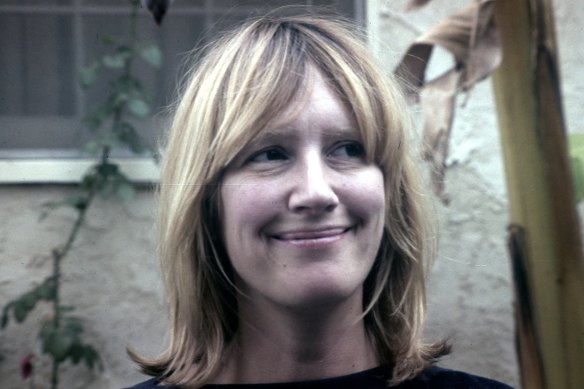
Like Didion, she’s repelled by the obviousness of early 1970s feminist art – “The whole women’s thing that is going on right now is so stark and obscene most of the time that no wonder one recoils in horror” – but she denounces Didion’s dismissive attitude to sexism, and her willingness to be co-opted into a literary hierarchy that perpetuates it: “It embarrasses me that you don’t read Virginia Woolf. I feel as though you think she’s a ‘woman’s novelist’ and that only foggy brains could like her and that you, sharp, accurate journalist, you would never join the ranks of people who sogged about in The Waves. You prefer to be with the boys snickering at the silly women and writing accurate prose about [a female alter-ego] who had everything but Art. Vulgar, ill-bred, drooling, uninvited Art. It’s the only thing that’s real apart from murder, I sometimes think – or death.”

Eve Babitz in 1978Credit: Mirandi Babitz
If Didion was afraid of Virginia Woolf, she was totally fearless about sacrificing her life for literary success. Anolik dishes dirt that suggests Didion’s marriage was one of convenience, her husband a closeted bisexual willing to edit her work “by the line”; she unearths evidence that Didion ruthlessly cannibalised intimacies for her fiction – a miscarriage while pregnant to the man she loved and effectively outing gay friends by transparently basing characters on them.
Many will agree with Anolik’s assessment of Didion’s “violation of her misanthropic integrity” in The Year of Magical Thinking and Blue Nights, which between them falsely mythologised her grief and marriage, and contrived to ignore the alcoholism – both Didion and Dunne were “heavy drinkers, especially later on” according to Bret Easton Ellis – that almost certainly led to their adopted daughter Quintana’s early death from acute pancreatitis.
Perhaps the sharpest measure of Didion’s ruthlessness might be the hideous story that she hid herself away to work on proofs for her latest book as the family gathered to see whether her niece, Dominique Dunne, star of the film Poltergeist, would survive a brutal assault that left her on life-support. (Dominique died.)
Loading
Babitz could never have brought herself to betray her life and many loves for a literary career. To her, success “smelt like burnt cloth and rancid gardenias”. Not that she was unambitious. Aged 18, she wrote a letter to Catch-22 author Joseph Heller that would’ve seduced a saint, and a much later one when Slow Days was published, disdaining what we now call “trauma porn” and taking the chance to boast and flirt and, crucially, to defend her art: “What I want to know is, if I tell everyone about my impending disease, Huntington’s … and about my grandma dying of cancer next door and how horrible it is being in love with a man who supposedly prefers men and how ghastly terrible it is watching my mother succumb to everyone dying around her, and what a showstopper it is every time my sister gets c— cancer, then do you think people will like me better? No. They’ll take one look at my tits and think I’ve got it made and am shallow and don’t know what’s what about characterisation. (Joe, I mean, you’ve seen me and know I simply can’t complain, it wouldn’t be fair, stacked the way I am.)”
Didion might have played the game to perfection, but Babitz wanted more than that. She wanted to change the game – to write as she lived, free from convention, to abandon accepted literary forms that didn’t feel authentic to her and to elevate the literary place of gossip, which had “always been regarded as some devious woman’s trick, some shallow, shameful way of grasping situations without being in on the top conferences with the serious men”.
Art – “vulgar, ill bred, drooling, uninvited Art” – was in Babitz’s blood. Stravinsky was her godfather. She’d read Proust’s A la recherche du temps perdu by 16 and her creative mind was as “stacked” as her chest.
Anolik makes us see Babitz’s unruly and undervalued genius anew, as a counterpoint to Didion’s imposing literary shadow. Hers is a dual biography that entertains and gossips and gives flesh to Didion’s maxim that “we tell ourselves stories in order to live”, getting under the skin of two women who got under each other’s, enlarging our perceptions of literary possibility in the process.



